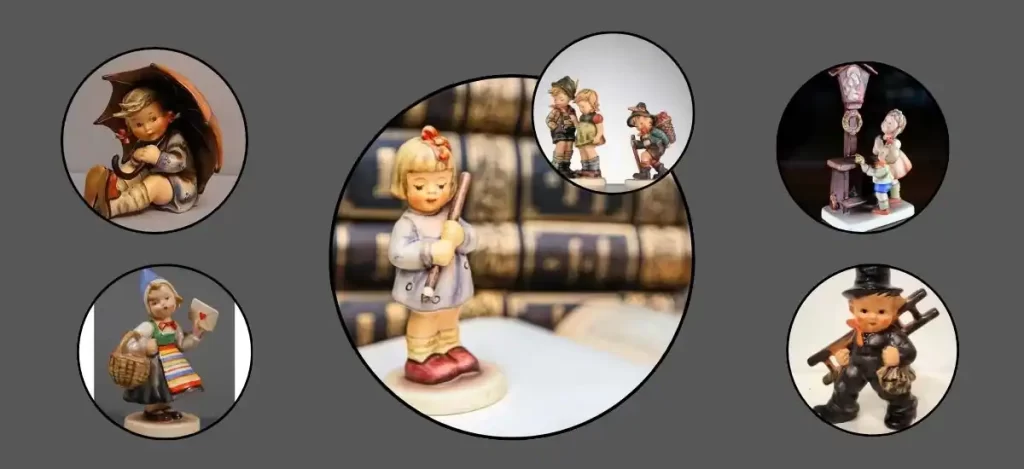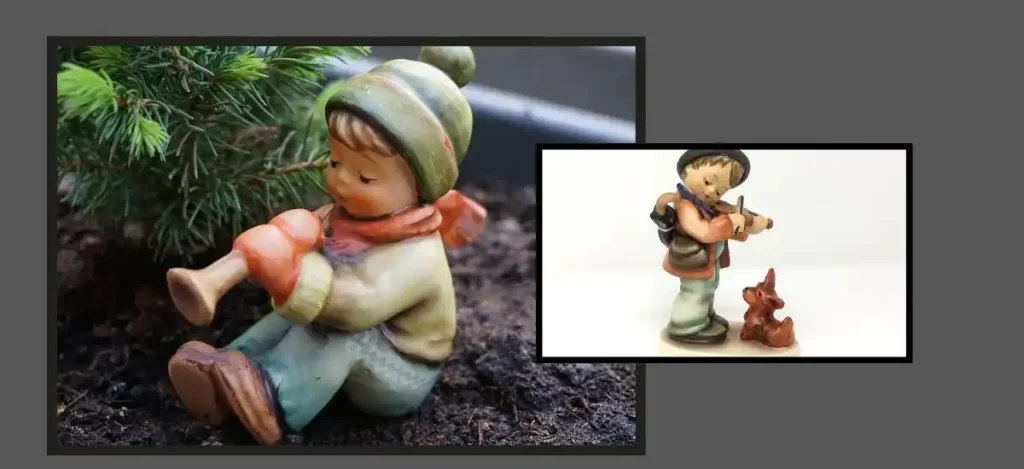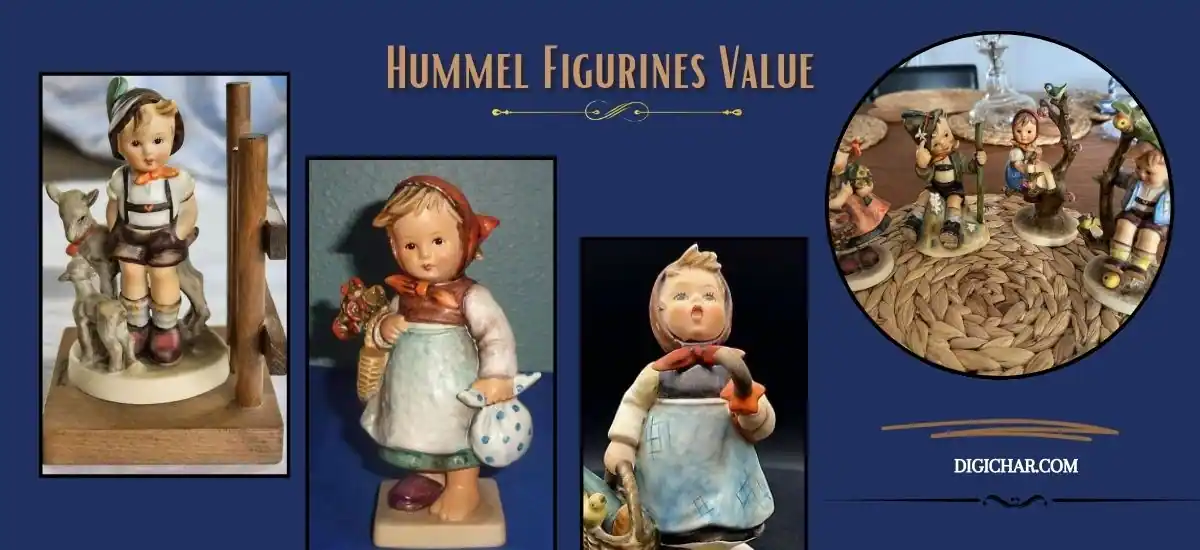Hummel figurines are a delightful and classic collectible, cherished by many for their unique charm and history. Originating from the artistic vision of Sister Maria Innocentia Hummel, these figurines first came into being in the early 1930s in Germany. The figurines are based on her whimsical and endearing drawings of children, which captured the hearts of the Franz Goebel porcelain company, leading to the creation of the Hummel figurines we know today.
The value of Hummel figurines can vary significantly, influenced by several factors. Key among them are the age, condition, rarity, and demand for the particular figurine. Older figurines, especially those made before the death of Sister Maria in 1946, tend to be more valuable.
Factors Influencing Value

- Age And Markings: The age of a Hummel figurine significantly impacts its value. Early pieces, particularly those marked with a “crown mark” or “full bee” trademark (TMK-1 and TMK-2, used from 1935 to 1955), are generally more sought after. The trademark on a Hummel figurine, found on its base, changes over the years, and these marks help in identifying and dating the figurines, thus influencing their collectible value.
- Condition: Condition is paramount in determining a figurine’s value. Collectors prefer items without any damage – no chips, cracks, crazing, or repairs. The original vibrancy of the paint and the absence of fading also play a crucial role.
- Rarity And Demand: Some figurines were produced in limited quantities or for a short period, making them rarer and often more valuable. Limited edition releases, unique variants, or those that were retired early often command higher prices. The “Adventure Bound” (Hummel 347) is a classic example, known for its rarity and value.
- Size And Complexity: Larger and more complex figurines, which required more skill and time to produce, can be more valuable. The number of figures in a piece, intricate details, and the overall size contribute to its value.
Market Trends
The market for Hummel figurines has evolved. Their heyday was in the mid-20th century, especially in the post-WWII era when American soldiers stationed in Germany sent them home as gifts, sparking a collecting frenzy in the United States.
However, like many collectible items, their popularity and market value have fluctuated. The advent of the internet and online auction platforms has both broadened the market and provided more transparency in pricing, but it has also led to a saturation in some areas, affecting prices.
Historical Context And Production

1. Inception And World War II Impact: The collaboration between Sister Maria Innocentia Hummel and the Goebel company started in the 1930s. Interestingly, the Second World War had a significant impact on the production and distribution of Hummel figurines.
Production continued during the war, but the figurines were less accessible outside Germany. Post-war, American soldiers stationed in Germany discovered these figurines and began sending them back home, which significantly boosted their popularity in the United States.
2. Materials And Craftsmanship: The figurines are traditionally made from porcelain. The production process involves sculpting a master model, usually from clay, which is then used to create a plaster mold. Liquid ceramic slip is poured into these molds to form the figurine.
After removal from the mold, each piece is hand-painted, making each figurine subtly unique. This high level of craftsmanship is a significant factor in the charm and value of Hummel figurines.
Themes And Series
- Variety Of Themes: Hummel figurines cover a wide range of themes, primarily focused on children and their activities. Common themes include children playing, singing, in religious settings, with animals, or depicting seasons and professions.
- Special Editions And Series: There are also special series and editions, such as the “Century Collection,” which are highly sought after. Limited edition series or those produced to mark special occasions or anniversaries often have higher value.
Market Considerations
- Generational Shifts: The market for Hummel figurines is subject to generational shifts in collecting trends. As the primary market of collectors ages, the demand for these figurines can fluctuate, impacting their market value.
- Authenticity And Reproductions: Ensuring authenticity is crucial in collecting Hummel figurines, as reproductions and fakes do exist. Authentic Hummel pieces will have a Goebel trademark and a model number on the base. Knowledge of these marks and the history of their changes is important for collectors.
Cultural Impact

1. Representation In Popular Culture: Hummel figurines have been referenced in various cultural contexts, reflecting their widespread recognition and nostalgic appeal. They have appeared in movies, television shows, and other forms of media, often symbolizing innocence and nostalgia.
2. Global Collecting Community: The charm of Hummel figurines transcends borders, creating a global community of collectors. This international interest adds to the figurines’ appeal, with collectors often sharing stories, tips, and experiences across different countries and cultures.
Conclusion
Hummel figurines are much more than mere decorative items. They represent a rich tapestry of history, artistry, and community. For collectors, each figurine tells a story, whether it’s about the era it was made, the artist who painted it, or the personal journey it took to become part of a collection.
In the world of Hummels, every detail counts, from the trademark on the base to the slightest variation in a figurine’s expression. This level of detail and history is what makes collecting Hummel figurines a deeply rewarding hobby for so many people around the world.
Frequently Asked Questions
Q 1. What Makes Early Hummel Figurines Unique?
Ans: Early Hummel figurines, especially those produced before 1950, are distinguished by their markings and craftsmanship. The “Crown Mark” and “Full Bee” trademarks indicate some of the earliest pieces, highly prized for their historical value and rarity.
Q 2. How Can You Identify a Rare Hummel Figurine?
Ans: Rare Hummels can be identified by checking for limited edition marks, unique design variations, or production numbers. Special editions made for short periods or in small quantities are typically rarer. Additionally, prototypes or models that were never mass-produced are considered rare finds.
Q 3. Are There Any Controversial or Banned Hummel Figurines?
Ans: Yes, there have been a few Hummel figurines that stirred controversy or were withdrawn from production. For instance, certain figurines made during World War II were discontinued post-war due to their association with Nazi propaganda.
Q 4. Can Hummel Figurines Be Restored Without Losing Value?
Ans: Restoration can be tricky. Professional restoration may maintain or increase value, especially if it prevents further damage. However, over-restoration or amateur repairs can significantly diminish a figurine’s value. Collectors generally prefer well-preserved original condition.
Q 5. How Did World Events Affect Hummel Production?
Ans: World events, notably World War II, had a significant impact on Hummel production. Materials were scarce, and production was limited during the war. Post-war, the American soldier’s interest in these figurines greatly expanded their popularity and distribution.

